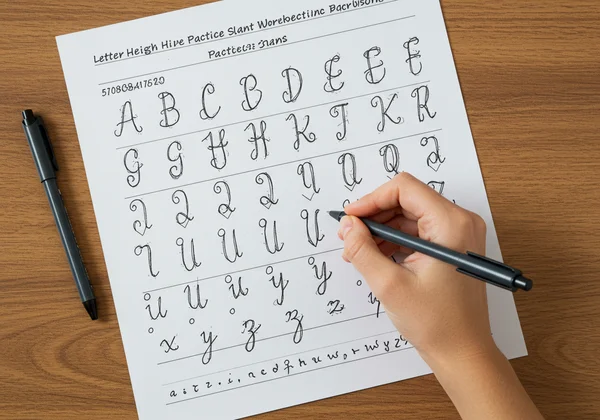Master Your Cursive Alphabet: Ultimate Practice Plan
Ready to truly master cursive handwriting? While individual lessons are great, a structured approach is the key to consistent, tangible progress. Many learners wonder, what is the best way to start learning cursive effectively? The answer lies in having a solid plan. This guide will help you create a personalized cursive alphabet practice plan that leverages effective learning strategies, turning sporadic efforts into a rewarding daily routine.
A dedicated plan transforms the journey from daunting to doable. It provides direction, helps you track your improvement, and keeps you motivated. By integrating the right tools and techniques, you can unlock the elegant flow of cursive writing much faster than you think. Let's build a roadmap to success together and start your plan today.
Why a Cursive Practice Plan Matters for Learning
Jumping into cursive without a plan is like trying to build a house without a blueprint. You might get a wall or two up, but the structure won't be sound. A well-designed cursive practice plan provides the framework needed for lasting skill development. It ensures you cover all the essential elements, from individual letters to connected words, in a logical sequence.
This systematic approach helps you build good habits from the start, so you don't have to fix mistakes down the line. It also helps you manage your time efficiently, making the most out of every practice session. By establishing a routine, you build the discipline and muscle memory required for fluent, beautiful handwriting.

Setting SMART Goals for Your Cursive Learning Schedule
To make your cursive learning schedule truly effective, it needs clear objectives. The SMART goal framework is a perfect tool for this. It ensures your targets are well-defined and achievable.
- Specific: Instead of "get better at cursive," aim for "master the lowercase 'a', 'b', and 'c' this week."
- Measurable: Track your success. You can measure it by how many times you can write a letter perfectly or by completing a full practice worksheet.
- Achievable: Set realistic goals. If you're a beginner, don't expect to write flawless paragraphs in your first week. Focus on foundational strokes and individual letters first.
- Relevant: Your goals should align with your overall objective of mastering the
cursive writing alphabet. Each small step should contribute to the bigger picture. - Time-bound: Set deadlines. For example, "I will learn all lowercase letters within one month." This creates a sense of urgency and helps you stay on track.
The Benefits of Learning Cursive Daily
Practicing consistently beats trying to cram everything in at once. A short, focused session every day is far more beneficial than a single long session once a week. Learning cursive daily reinforces muscle memory, making the fluid motions of cursive second nature. This regular practice builds a strong mind-body connection, improving both speed and legibility over time.
Daily practice also keeps the material fresh in your mind. It helps you build momentum and prevents the frustration of having to re-learn concepts you've forgotten. Even 15 minutes a day can lead to remarkable progress, making cursive a calming and rewarding part of your daily routine.

Crafting Your Effective Cursive Practice Schedule
Now that you understand the "why," let's dive into the "how." An effective cursive practice schedule is balanced, incorporating different elements to keep you engaged and ensure comprehensive learning. The goal is to create a routine that you can stick with consistently.
Your schedule should be a guide, not a rigid set of rules. Feel free to adapt it to your learning pace and personal preferences. The most important thing is to practice deliberately, focusing on the quality of your strokes rather than just the quantity.
Essential Components of a Daily Cursive Routine
A well-rounded daily cursive routine should include a few key stages. Dedicate about 15-20 minutes each day to this simple structure:
-
Warm-up (2-3 minutes): Start with basic drills. Practice making loops, waves, and zig-zag lines across the page. This prepares the muscles in your hand and arm for the fluid movements of cursive.
-
Letter Practice (5-7 minutes): Focus on a small group of letters. Use a
cursive alphabet worksheetto trace the letters, then practice writing them on your own. Pay close attention to the correct height, slant, and spacing. -
Connection Practice (3-5 minutes): Cursive is all about connections. Practice connecting the letters you focused on. Write simple pairs like 'an', 'br', or 'ol' to get a feel for how letters flow into one another.
-
Word and Sentence Practice (5 minutes): Put it all together. Write out short words and simple sentences using the letters you've mastered. This helps you apply your skills in a practical context.

Leveraging Cursive Alphabet Tools in Your Plan
Our platform is designed to be your one-stop resource for learning cursive. On our platform, we offer a comprehensive set of free tools to integrate directly into your practice plan. You can explore our worksheets to find printable guides for every letter from A to Z. These sheets provide clear stroke guidance and ample space for practice.
For creative application and motivation, use our Cursive Font Generator. Type in your practice words or a favorite quote, and see it instantly rendered in beautiful script. You can copy this to use as a reference or simply to inspire you. Integrating these interactive tools makes your self-study cursive journey more engaging and effective.
Tracking Your Cursive Handwriting Progress
Seeing how far you've come is a powerful motivator. Make tracking your cursive handwriting progress a part of your plan. Get a dedicated notebook for your cursive practice. Date every entry, so you can look back and see the improvements you've made over time.
Once a week, write out the same sentence, such as "The quick brown fox jumps over the lazy dog." Keep these weekly samples together. Comparing your handwriting from week one to week five will reveal incredible growth in your consistency, spacing, and flow, reinforcing that your effective cursive practice is paying off.
![]()
Overcoming Obstacles in Your Self-Study Cursive Journey
Learning anything new, including cursive on your own, can have its tough spots. You might feel your progress is slow, or you might struggle with a particularly tricky letter connection. The key is to anticipate these hurdles and have strategies ready to overcome them.
Remember that patience is crucial. Handwriting is a physical skill that takes time to develop. Celebrate small victories and don't be discouraged by occasional setbacks. Staying positive and persistent is half the battle.
Staying Motivated to Learn Cursive
Losing steam is natural, but you can keep your enthusiasm high. Find ways to make practice fun. Instead of just writing random words, write the lyrics to your favorite song or a line from a beloved book. Use colorful pens or high-quality paper to make the experience more enjoyable.
Set small, achievable rewards for yourself. When you master all the lowercase letters, treat yourself. Share your progress with a friend or family member for encouragement. Finding a community or a learning partner can also make a huge difference in staying motivated.
Adjusting Your Cursive Learning Schedule as You Improve
Your plan should evolve with you. As you master the basics, it's time to adjust your cursive learning schedule to tackle new challenges. Once you're comfortable with individual letters, shift your focus more toward connections and word fluency.
Move from single words to full sentences and eventually to paragraphs. Start practicing by writing journal entries, thank-you notes, or letters to friends. This real-world application is the ultimate goal of learning cursive. A flexible plan means you're always growing and moving forward.
Your Path to Fluent Cursive Handwriting Starts Now
Building an effective practice plan is the most important step you can take toward mastering the beautiful art of cursive. By setting clear goals, practicing daily, and leveraging the right resources, you create a clear path to success. A structured routine builds confidence, develops muscle memory, and transforms a challenging task into a delightful skill.
You have the roadmap, and all the tools you need are right here. Get started today by exploring our free printable worksheets and interactive tools. Your journey to elegant, fluent handwriting is just a click away.
Frequently Asked Questions About Cursive Practice Plans
How can I quickly learn cursive with a practice plan?
While "quickly" is relative, a structured plan is the fastest method. Focus on daily 15-20 minute sessions rather than infrequent long ones. Use a plan that builds from basic strokes to letters, then words, to ensure you don't have to go back and fix bad habits. Consistency is the key to speed.
What is the best way to start learning cursive effectively?
The best way is to start with a plan that includes high-quality resources. Begin with printable worksheets that show the correct stroke order for each letter. Our platform offers a complete a to z cursive alphabet chart and individual practice sheets to build a strong foundation.
How often should I practice cursive handwriting for best results?
For the best results, you should practice daily. Short, consistent sessions of 15-20 minutes are more effective for building muscle memory and retaining information than one long session per week. A daily cursive schedule will yield noticeable improvements in a short time.
Can a daily cursive schedule really improve my writing?
Absolutely. A daily schedule creates a habit and systematically builds your skills. It trains your hand to make the fluid motions of cursive automatically, improving your writing's speed, legibility, and elegance. Consistent effort is the single most important factor for improvement.
What resources are best for a self-study cursive journey?
The best resources are comprehensive, accessible, and free. A great self-study toolkit includes printable letter worksheets, guides on letter connections, and tools for creative practice. You can find your resources right here, from detailed practice sheets to a fun Cursive Font Generator to keep you motivated.